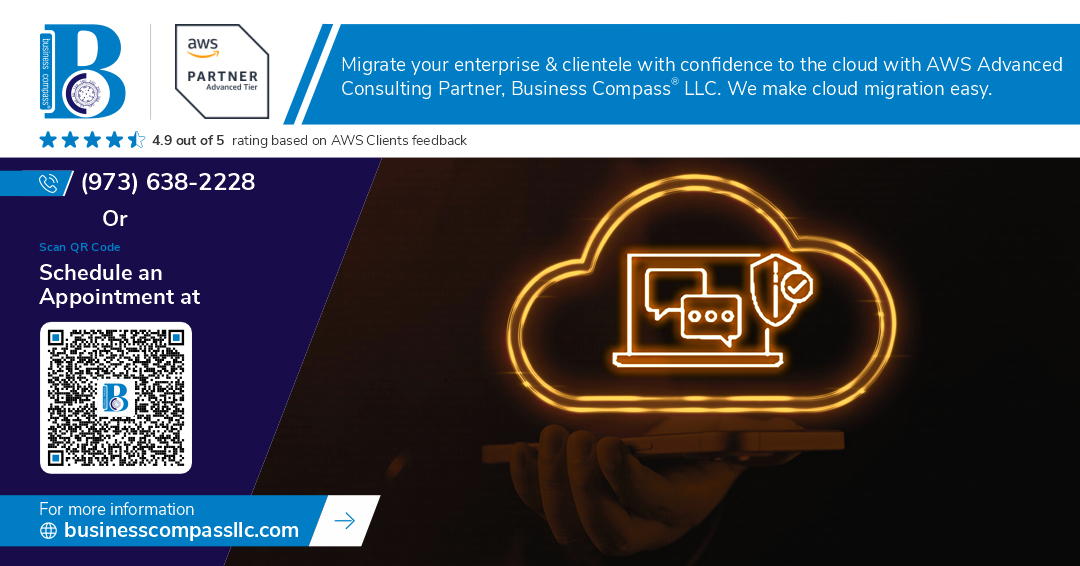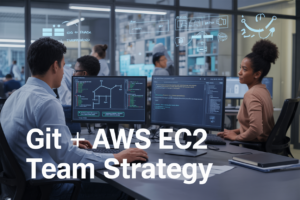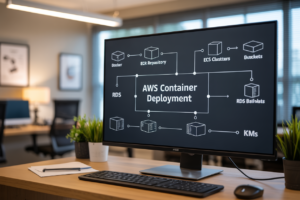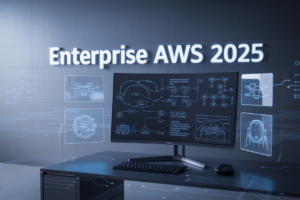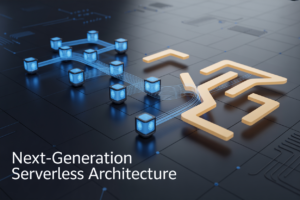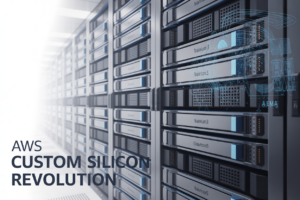🚀 In the ever-evolving landscape of cloud computing, AWS Compute Services have become the backbone of countless organizations. But with great power comes great responsibility – and a maze of compliance and governance challenges. Are you confident that your EC2 instances, Lambda functions, and containerized applications are operating within the bounds of industry regulations and best practices?
Navigating the intricate world of compliance and governance for AWS Compute Services can feel like trying to solve a Rubik’s Cube blindfolded. From establishing robust security measures to implementing effective cost management strategies, the task can seem overwhelming. But fear not! This comprehensive guide will equip you with the knowledge and tools to master compliance and governance best practices for EC2, Lambda, Fargate, ECS, and EKS.
Join us as we dive deep into the essential components of a strong compliance framework, explore cutting-edge security practices, and uncover strategies for automating governance processes. We’ll also examine how to optimize resource utilization, implement disaster recovery plans, and create comprehensive compliance reports. By the end of this journey, you’ll be well-prepared to tackle the challenges of managing AWS Compute Services with confidence and precision. Let’s get started! 💪
Understanding AWS Compute Services
Overview of EC2, Lambda, Fargate, ECS, and EKS
AWS offers a diverse range of compute services to cater to various application needs. Let’s explore the key features of each service:
| Service | Type | Use Case | Scalability |
|---|---|---|---|
| EC2 | Virtual Machines | Traditional applications | Manual/Auto Scaling |
| Lambda | Serverless Functions | Event-driven tasks | Automatic |
| Fargate | Serverless Containers | Microservices | Automatic |
| ECS | Container Orchestration | Containerized apps | Manual/Auto Scaling |
| EKS | Managed Kubernetes | Complex containerized apps | Manual/Auto Scaling |
- EC2 (Elastic Compute Cloud): Provides resizable compute capacity in the cloud, ideal for applications requiring full control over the computing environment.
- Lambda: Enables running code without provisioning servers, perfect for short-running, event-driven tasks.
- Fargate: Offers serverless compute for containers, allowing you to focus on application development without managing infrastructure.
- ECS (Elastic Container Service): Facilitates easy deployment, management, and scaling of containerized applications.
- EKS (Elastic Kubernetes Service): Provides a managed Kubernetes service for running containerized applications at scale.
Importance of compliance and governance in cloud computing
Compliance and governance are crucial aspects of cloud computing for several reasons:
- Risk mitigation: Helps identify and address potential security threats and vulnerabilities.
- Regulatory adherence: Ensures compliance with industry-specific regulations and standards.
- Data protection: Safeguards sensitive information and maintains customer trust.
- Operational efficiency: Streamlines processes and reduces the likelihood of errors or breaches.
Key differences in managing compliance across compute services
Managing compliance across different AWS compute services requires tailored approaches:
- EC2: Focuses on instance-level security, network configuration, and access controls.
- Lambda: Emphasizes code security, function permissions, and event source management.
- Fargate: Concentrates on container image security and task definition configurations.
- ECS/EKS: Prioritizes cluster security, container orchestration policies, and network isolation.
Each service demands unique strategies to ensure comprehensive compliance and governance.
Establishing a Robust Compliance Framework
A. Identifying relevant regulatory requirements
When establishing a robust compliance framework for AWS Compute services, the first step is to identify the regulatory requirements applicable to your organization. This process involves:
- Industry-specific regulations
- Geographic considerations
- Data protection laws
- Security standards
Here’s a table summarizing common regulatory requirements:
| Regulation | Industry | Geographic Scope |
|---|---|---|
| GDPR | All | EU |
| HIPAA | Healthcare | US |
| PCI DSS | Financial | Global |
| SOC 2 | All | Global |
B. Developing compliance policies and procedures
Once you’ve identified the relevant regulations, develop comprehensive policies and procedures tailored to your AWS Compute environment:
- Access control policies
- Data encryption standards
- Incident response procedures
- Audit and logging requirements
C. Implementing continuous compliance monitoring
Continuous monitoring is crucial for maintaining compliance:
- Utilize AWS Config for resource tracking
- Implement CloudWatch for real-time monitoring
- Set up SNS alerts for compliance violations
- Regularly conduct internal audits
D. Leveraging AWS compliance programs and certifications
AWS offers various compliance programs and certifications to help organizations meet their regulatory requirements:
- AWS Artifact: Access compliance reports
- AWS Compliance Center: Stay updated on compliance offerings
- Third-party audits: Leverage AWS’s compliance with standards like ISO 27001 and SOC reports
By following these steps, you can establish a robust compliance framework for your AWS Compute services. This foundation will help ensure that your organization meets regulatory requirements while leveraging the full potential of AWS’s compute offerings.
Security Best Practices for AWS Compute Services
Identity and Access Management (IAM) strategies
Implementing robust IAM strategies is crucial for securing AWS compute services. Here are key best practices:
- Principle of Least Privilege (PoLP)
- Multi-Factor Authentication (MFA)
- Regular access reviews
- Use of IAM roles for EC2 instances
| IAM Strategy | Description | Benefit |
|---|---|---|
| PoLP | Grant minimal permissions | Reduces attack surface |
| MFA | Require additional authentication | Enhances account security |
| Access reviews | Periodically audit user permissions | Maintains up-to-date access control |
| IAM roles | Assign roles to EC2 instances | Eliminates need for hardcoded credentials |
Network security and isolation techniques
Securing your network is essential for protecting AWS compute resources:
- Implement Virtual Private Clouds (VPCs)
- Use security groups and network ACLs
- Set up private subnets for sensitive workloads
- Employ VPN or Direct Connect for secure communication
Data encryption at rest and in transit
Encryption is a critical component of AWS compute security:
- Use AWS Key Management Service (KMS) for key management
- Enable encryption for EBS volumes, S3 buckets, and RDS instances
- Implement SSL/TLS for data in transit
- Utilize AWS Certificate Manager for managing SSL/TLS certificates
Vulnerability management and patching
Regular vulnerability assessments and patching are vital:
- Use AWS Systems Manager for automated patching
- Implement Amazon Inspector for vulnerability scans
- Regularly update AMIs and container images
- Monitor security bulletins and apply patches promptly
By implementing these security best practices, you can significantly enhance the protection of your AWS compute services. Next, we’ll explore governance strategies to ensure ongoing compliance and efficient management of your AWS compute environments.
Governance Strategies for AWS Compute Environments
Implementing effective tagging policies
Effective tagging is crucial for managing AWS compute resources. Implement a comprehensive tagging strategy to enhance governance and visibility across your compute environments. Here’s a breakdown of key tagging categories:
| Tag Category | Purpose | Example |
|---|---|---|
| Cost Center | Allocate expenses | CostCenter: Marketing |
| Environment | Identify deployment stage | Environment: Production |
| Application | Associate resources with apps | Application: WebApp01 |
| Owner | Assign responsibility | Owner: DevOps-Team |
| Compliance | Track regulatory requirements | Compliance: HIPAA |
Enforce tagging policies using AWS Tag Policies and automate tag management with AWS Resource Groups Tagging API.
Utilizing AWS Organizations for multi-account management
AWS Organizations enables centralized management of multiple AWS accounts, providing:
- Consolidated billing
- Hierarchical account structure
- Centralized policy management
Create a well-structured organizational hierarchy:
- Root account for billing and high-level management
- Security account for centralized security controls
- Separate accounts for development, testing, and production environments
- Dedicated accounts for specific applications or business units
Enforcing resource constraints with Service Control Policies (SCPs)
SCPs are powerful tools for enforcing governance across your AWS organization. Use them to:
- Restrict access to specific AWS services
- Enforce compliance requirements
- Implement least-privilege access
Example SCP to restrict EC2 instance types:
{
"Version": "2012-10-17",
"Statement": [
{
"Sid": "LimitEC2InstanceTypes",
"Effect": "Deny",
"Action": "ec2:RunInstances",
"Resource": "arn:aws:ec2:*:*:instance/*",
"Condition": {
"StringNotLike": {
"ec2:InstanceType": ["t3.*", "m5.*"]
}
}
}
]
}
Monitoring and auditing with AWS CloudTrail and Config
Leverage AWS CloudTrail and Config for comprehensive monitoring and auditing:
- CloudTrail: Records API calls and account activity
- Config: Tracks resource configurations and changes over time
Implement automated compliance checks using AWS Config Rules. Set up CloudWatch alarms to alert on suspicious activities or policy violations. Regularly review CloudTrail logs and Config reports to ensure ongoing compliance and identify potential security risks.
Automating Compliance and Governance
Infrastructure as Code (IaC) for consistent deployments
Infrastructure as Code (IaC) is a critical component in automating compliance and governance for AWS compute services. By using tools like AWS CloudFormation or Terraform, organizations can ensure consistent and repeatable deployments across their environments. Here’s a comparison of popular IaC tools:
| Tool | AWS Native | Multi-Cloud Support | Learning Curve |
|---|---|---|---|
| CloudFormation | Yes | No | Moderate |
| Terraform | No | Yes | Steep |
| AWS CDK | Yes | Limited | Moderate |
Benefits of using IaC for compliance and governance:
- Version control: Track changes and rollback if needed
- Automated testing: Validate configurations before deployment
- Compliance as code: Embed compliance rules directly into templates
- Scalability: Easily replicate compliant environments
Leveraging AWS Systems Manager for configuration management
AWS Systems Manager provides powerful capabilities for managing and maintaining compliance across your compute resources. Key features include:
- Parameter Store: Securely store and manage configuration data
- State Manager: Ensure instances maintain a desired state
- Patch Manager: Automate OS and application patching
- Inventory: Track and audit software and configurations
Implementing automated compliance checks
Automated compliance checks are essential for maintaining a secure and compliant environment. AWS Config and AWS Security Hub offer robust solutions:
- AWS Config: Define rules and evaluate resource configurations
- AWS Security Hub: Centralize security alerts and compliance status
Using AWS Lambda for custom governance functions
AWS Lambda enables the creation of custom governance functions to address unique compliance requirements. Use cases include:
- Real-time monitoring of resource changes
- Automated remediation of non-compliant resources
- Custom reporting and alerting
By implementing these automation strategies, organizations can significantly improve their compliance posture and reduce the risk of governance failures in their AWS compute environments.
Optimizing Cost Management and Resource Utilization
Implementing cost allocation tags
Cost allocation tags are essential for organizing and tracking AWS resources effectively. By implementing a comprehensive tagging strategy, you can:
- Identify cost centers
- Attribute expenses to specific projects or departments
- Enhance visibility into resource utilization
Here’s a simple example of cost allocation tags:
| Resource | Project | Department | Environment |
|---|---|---|---|
| EC2 Instance | WebApp | Marketing | Production |
| Lambda Function | DataProcessing | Finance | Development |
| ECS Cluster | MobileBackend | IT | Staging |
Utilizing AWS Budgets and Cost Explorer
AWS Budgets and Cost Explorer are powerful tools for managing and analyzing your AWS spending:
- Set up customized budgets
- Receive alerts for overspending
- Visualize cost trends over time
- Identify cost-saving opportunities
Right-sizing compute resources
Proper resource allocation is crucial for optimizing costs. Consider the following:
- Analyze performance metrics
- Adjust instance types based on workload requirements
- Implement auto-scaling to match demand
Leveraging spot instances and reserved capacity
To further reduce costs:
- Use spot instances for non-critical, interruptible workloads
- Purchase reserved instances for predictable, long-term usage
- Combine different pricing models to maximize savings
Now that we’ve covered cost optimization strategies, let’s explore disaster recovery and business continuity measures to ensure the resilience of your AWS compute environment.
Disaster Recovery and Business Continuity
Designing for high availability across regions
To ensure business continuity and disaster recovery, designing for high availability across regions is crucial. AWS provides multiple tools and services to achieve this:
- Multi-AZ deployments
- Cross-region replication
- Amazon Route 53 for global DNS management
| Feature | Description | Benefit |
|---|---|---|
| Multi-AZ | Deploy resources across multiple Availability Zones | Increased fault tolerance |
| Cross-region replication | Replicate data and resources across regions | Geographic redundancy |
| Route 53 | Global DNS service with health checks and failover | Intelligent traffic routing |
Implementing backup and restore strategies
Effective backup and restore strategies are essential for data protection and quick recovery. Consider the following approaches:
- Use AWS Backup for centralized management
- Implement regular snapshots for EC2 instances and EBS volumes
- Utilize S3 cross-region replication for data backups
- Leverage AWS Database Migration Service for database backups
Testing disaster recovery plans
Regular testing of disaster recovery plans is crucial to ensure their effectiveness:
- Conduct tabletop exercises
- Perform periodic failover tests
- Simulate various disaster scenarios
- Document and refine recovery procedures based on test results
Ensuring data residency compliance
Data residency compliance is critical for many organizations. To address this:
- Use AWS Regions and Local Zones to meet specific geographic requirements
- Implement strict access controls and encryption for data at rest and in transit
- Utilize AWS Organizations and Service Control Policies to enforce data residency rules
- Regularly audit data flows and storage locations to maintain compliance
Now that we’ve covered disaster recovery and business continuity strategies, let’s explore how to effectively report on and document compliance efforts.
Compliance Reporting and Documentation
Generating compliance reports with AWS Artifact
AWS Artifact is a valuable tool for generating compliance reports for your AWS Compute services. It provides on-demand access to AWS security and compliance documents, including SOC reports, PCI reports, and ISO certifications. These reports can be easily downloaded and shared with auditors or stakeholders.
| Report Type | Description | Relevance |
|---|---|---|
| SOC Reports | Service Organization Control reports | Demonstrates AWS’s security controls |
| PCI DSS | Payment Card Industry Data Security Standard | Essential for handling payment data |
| ISO Certifications | International Organization for Standardization | Proves adherence to global standards |
Implementing automated compliance dashboards
Automated compliance dashboards provide real-time visibility into your AWS Compute environment’s compliance status. Utilize AWS Config and CloudWatch to create custom dashboards that display:
- Resource configuration changes
- Compliance rule violations
- Security group modifications
- IAM policy updates
Maintaining up-to-date documentation
Keeping documentation current is crucial for compliance. Implement a documentation management system that includes:
- Regular review cycles
- Version control
- Automated updates for resource changes
- Clear ownership and responsibilities
Preparing for audits and assessments
To ensure readiness for compliance audits:
- Conduct regular internal assessments
- Maintain an audit trail of all changes and access
- Prepare a compliance evidence package
- Train staff on audit procedures and requirements
By following these practices, you’ll establish a robust compliance reporting and documentation process for your AWS Compute services, ensuring you’re always prepared for audits and can demonstrate adherence to regulatory requirements.
Implementing robust compliance and governance practices for AWS compute services is crucial for maintaining a secure, efficient, and compliant cloud environment. By establishing a comprehensive framework, adhering to security best practices, and leveraging automation, organizations can effectively manage their AWS compute resources while meeting regulatory requirements and internal policies.
To ensure long-term success, regularly review and update your compliance and governance strategies, stay informed about new AWS features and industry regulations, and continuously optimize your cost management and resource utilization. By following these best practices, you can build a resilient and compliant AWS compute infrastructure that supports your business objectives and fosters innovation while minimizing risks.










